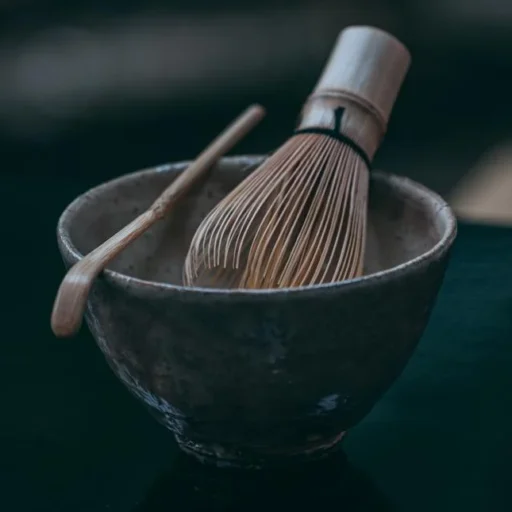茶道における畳の縁の踏み方と歩き方の作法
茶道では、畳の「縁(へり)」を踏まないことが基本的なマナーとされています。これは、畳の縁には家紋が入ることがあり、格式のある場所では特に重要視されてきたためです。また、踏むことで畳が傷みやすくなるという実用的な理由もあります。
さらに、畳の縁をまたぐ際には、流派ごとに決まった足の運び方があります。
• 裏千家では 右足から入って左足で出る
• 表千家では 左足から入って右足で出る
このように、流派によって足の動かし方が異なるのも茶道の特徴の一つです。何気ない動作の中にも、型や美しさが重視されています。
お茶席に入る際の作法:床の間の拝見
お茶席に入るとき、まず最初に行うのが床の間(とこのま)の拝見です。床の間には、掛け軸や生け花が飾られており、茶席の主題や亭主のもてなしの心を感じ取る大切な場所です。
この床の間を拝見する際の足運びにも決まりがあります。
• 床の間へ向かうときは右足から
• 床の間から去るときは左足から
この動きには、茶道における流れるような所作の美しさが込められています。茶道では、一つひとつの動作が意味を持ち、自然で洗練された動きになるよう工夫されています。
茶道の歩き方:摺り足の意味と役割
茶室では、歩き方にも特有の作法があります。畳の上を歩くときは、つま先からではなく、土踏まずあたりを畳に擦りつけるように歩くのが基本です。この摺り足の歩き方には、単に音を立てずに静かに歩くという目的だけでなく、もう一つ大切な意味があります。
茶席では、客の足音が亭主への合図になります。襖の向こうにいる亭主は、客が茶室へ入る音を聞き、床の間を拝見し終え、すべての音が静まるのを確認してから、点前を始めます。そのため、まったく音を立てずに歩くのではなく、畳の上を擦るように歩くことで、適度な足音を立てることが大切なのです。
歩くときのポイントは、
• かかとから踏み込まず、土踏まずあたりを滑らせるように歩く
• 背筋を伸ばし、視線を自然に前に向ける
• 一歩一歩を丁寧に、ゆったりとした動きで進む
茶道の歩き方には、単なる所作以上の意味が込められています。客の動きを亭主に知らせ、すべての音が静まることで、一つの流れとして点前が始まる。こうした繊細な動作が、茶道の奥深さを形作っているのです。
The Role of Walking Etiquette in Tea Ceremony
In the practice of tea ceremony, it is important to avoid stepping on the tatami (woven mat) borders. This custom originates from the historical significance of tatami edges, which sometimes bear family crests, as well as the practical reason of preventing damage to the mats.
Additionally, different schools have specific ways of stepping over the tatami borders:
• Urasenke: Step in with the right foot and step out with the left foot.
• Omotesenke: Step in with the left foot and step out with the right foot.
These rules help maintain the graceful flow of movement within the tea room and reflect the differences between tea schools.
Entering the Tea Room: Paying Respect to the Tokonoma
When entering a tea room, the first important action is to pay respect to the tokonoma (alcove). The tokonoma displays a hanging scroll and flower arrangement, which express the theme of the tea gathering and the host’s hospitality.
• Step toward the tokonoma with your right foot.
• Step away from the tokonoma with your left foot.
This controlled movement emphasizes beauty and natural grace, which are central elements of the tea ceremony. Every movement in the tea room is intentional and designed to reflect mindfulness and respect.
The Meaning and Purpose of Suri-ashi (Sliding Steps) in Tea Ceremony
The way one walks in a tea room is also a key part of tea ceremony etiquette. Instead of stepping forward with the toes, one should gently slide the arch of the foot along the tatami. While this technique ensures that movement is graceful and does not disrupt the atmosphere, it also serves another important purpose.
In a tea gathering, the sound of the guests’ footsteps acts as a signal to the host. The host, waiting behind the sliding doors, listens carefully to the guests’ movements—when they enter, when they pay respects to the tokonoma, and when all sounds settle. Only after everything falls silent does the host begin the tea preparation (temae).
Key points to remember when walking in the tea room:
• Avoid stepping with the heel first; instead, glide the arch of the foot smoothly.
• Maintain a straight posture and keep a natural gaze forward.
• Move slowly and deliberately, taking each step with care.
The suri-ashi walking style is not just about moving quietly; it is a refined communication method between the guests and the host. When all sounds settle, it marks the perfect moment for the tea ceremony to begin. These subtle, almost imperceptible gestures embody the depth and elegance of tea culture.


